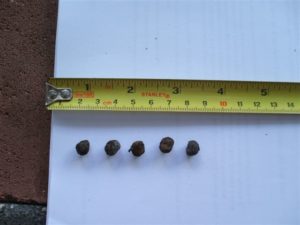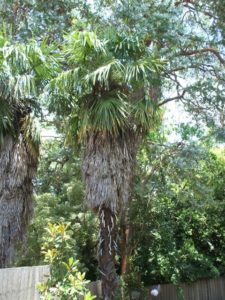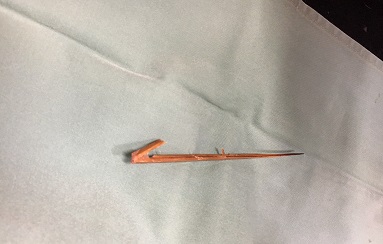True Palms can cause illness and injury in pets. (cf “Sago-Palm: Fake but poisonous Palm post)
Our most recent encounter with Palms and Pets was a tiny cat presented last month with a history of sudden onset aggression over the weekend. There was a small scab behind the cat’s front leg on its rib cage. Under anesthetic, we removed the 15cm fibrous spike above that came off a Palm tree in the backyard. The cat had an uneventful recovery and within 3 hours was back to her normal self.
If these thorns can do that to a light agile cat-how dangerous are they for dogs and children?
The owner noted that when he has just stabbed himself with the tips of these -your finger aches for days-this poor cat had this repeatedly stabbing it every time it moved. Other clients have identified this as a spiked frond from a Pigmy Date Palm. The spiked fronds can cause pain for many years especially if you pierce a joint. Their advice was to wear protective gear on everything if you intend to prune these palms.
The cat was perfect at suture removal 10 days later and we have heard nothing further in the intervening 4 months.
2)There are reports of dogs eating sufficient numbers of ripe seeds to cause gastrointestinal irritation showing as bloody stools and vomiting of the Chinese Windmill palm or Chusan Palm, despite the plant commonly thought not to be poisonous. The black ovoid ripe berries look like possum poo so can be overlooked when owners are asked to check the yard for possible toxins. My thanks to CVE Control & Therapy and to Nick Scott and Tim Campbell of Bathurst for alerting vets and owners to this issue and for allowing my use of their photographs.

3) Queen-Palms (or incorrectly Cocos Palm): Syagrus romanzoffiana, Arecastrum has been documented again by CVE & Anne Fawcett to cause vomiting and potential intestinal blockage. The dogs can sometimes eat them fine but can run into difficulties especially when the seeds are green. Even Bats find the green stage to be toxic. The advice from the Botanic gardens is ‘it is probably a good idea to get owners of such trees to watch out for green fruit fall after storms, sweep fruit up and dispose of them thoughtfully as this species is also becoming a major weed”.
